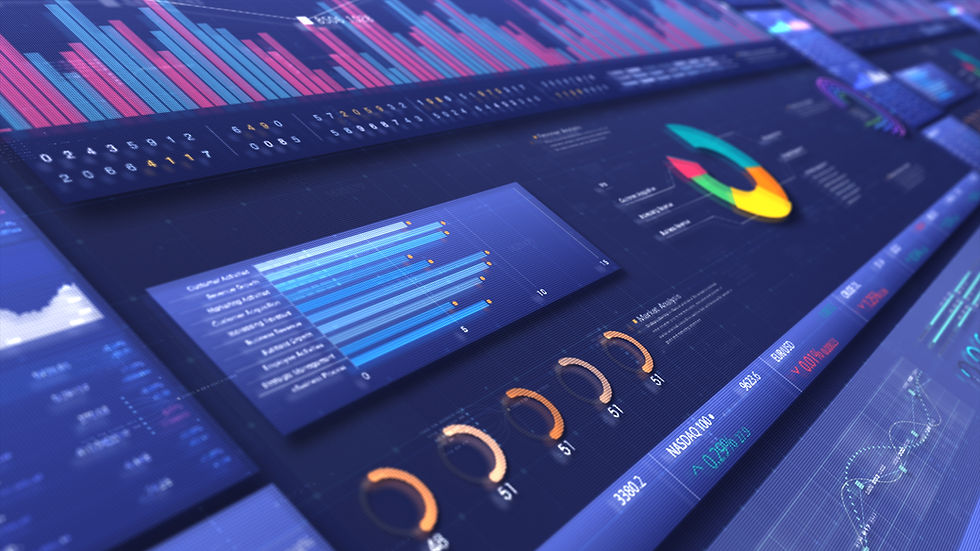Leveraging Data Analytics for Strategic Financial Planning
- Pairnipa

- 16 ต.ค. 2567
- ยาว 6 นาที
In today’s data-driven world, businesses across all industries are increasingly relying on data analytics to inform strategic decisions. Financial planning is one area where data analytics can offer transformative insights, enabling businesses to forecast with greater accuracy, manage risk effectively, and optimize performance. By harnessing the power of data, organizations can align their financial strategies with real-time market conditions and make more informed decisions that drive growth and profitability.
This article explores how leveraging data analytics can enhance strategic financial planning, helping businesses stay competitive in an ever-evolving economic landscape.

1. The Role of Data Analytics in Financial Planning
Data analytics involves collecting, processing, and analyzing large sets of financial and non-financial data to extract actionable insights. In strategic financial planning, data analytics helps organizations gain a deeper understanding of their financial health, forecast future performance, and make evidence-based decisions that align with long-term objectives.
a) Enhanced Financial Forecasting
Traditionally, financial forecasts were based on historical data and assumptions about future market conditions. While this approach remains valuable, data analytics introduces a new level of precision by incorporating real-time data, market trends, and predictive models into the forecasting process. This enables businesses to develop more accurate revenue projections, expense forecasts, and cash flow models.
By analyzing large volumes of data from various sources—such as sales figures, customer behavior, industry benchmarks, and macroeconomic indicators—companies can identify trends and patterns that may not be apparent through traditional forecasting methods. For example, machine learning algorithms can analyze historical data and predict how external factors, such as changes in consumer preferences or shifts in commodity prices, might impact future revenue.
Example: A retail company can use data analytics to forecast sales by analyzing customer purchase data, seasonal trends, and competitor pricing. This allows the company to create more precise financial projections and adjust its inventory and marketing strategies accordingly.
b) Improved Budgeting and Resource Allocation
Data analytics enhances the budgeting process by providing real-time insights into where resources are being utilized most effectively. By analyzing spending patterns and identifying inefficiencies, businesses can make informed decisions about resource allocation. Data-driven budgeting allows companies to prioritize high-impact areas and reduce unnecessary expenditures.
With the ability to drill down into specific cost drivers and revenue streams, finance teams can create more granular budgets that align with the company’s strategic goals. Data analytics also enables continuous monitoring of budget performance, allowing for dynamic adjustments as new data becomes available.
Example: A manufacturing company can leverage data analytics to optimize its production budget by analyzing material costs, labor expenses, and equipment utilization. The company can then reallocate resources to areas with the highest return on investment, such as automation or process improvements.
c) Risk Management and Scenario Analysis
One of the most significant advantages of data analytics in financial planning is its ability to enhance risk management. By using predictive analytics, companies can model various financial scenarios and assess the potential impact of different risks—such as economic downturns, regulatory changes, or supply chain disruptions—on their financial performance.
Scenario analysis allows businesses to simulate "what-if" situations, helping them prepare for potential challenges and develop contingency plans. This proactive approach to risk management reduces the likelihood of financial surprises and enables organizations to respond more effectively to changes in the business environment.
Example: A company concerned about currency fluctuations can use data analytics to model the impact of exchange rate changes on its international revenue. Based on this analysis, the company can implement hedging strategies to mitigate the risk.

2. Data-Driven Performance Management
In addition to improving forecasting and risk management, data analytics plays a key role in performance management by providing insights into key performance indicators (KPIs) and financial metrics. By tracking and analyzing financial data in real time, businesses can identify areas where performance is lagging and take corrective action.
a) Key Performance Indicators (KPIs) and Metrics Tracking
Financial planning often relies on key performance indicators (KPIs) to assess the company’s financial health and guide decision-making. Data analytics allows organizations to track KPIs such as profit margins, operating expenses, and cash flow on an ongoing basis, providing a more accurate and timely view of financial performance.
By monitoring KPIs in real time, businesses can quickly detect anomalies or trends that require attention. For example, if a company notices that its operating expenses are rising faster than revenue, data analytics can help pinpoint the source of the problem—whether it’s increased labor costs, supply chain inefficiencies, or other factors—and recommend strategies for cost reduction.
Example: A service-based company can use data analytics to monitor its revenue per employee, customer acquisition costs, and customer retention rates. This allows the company to make data-driven decisions about staffing, marketing investments, and customer service improvements.
b) Benchmarking and Competitive Analysis
Data analytics enables companies to benchmark their performance against industry peers and competitors. By analyzing financial data from publicly available sources or industry databases, businesses can gain insights into how they stack up against competitors in terms of profitability, efficiency, and growth.
Competitive analysis through data analytics helps companies identify strengths and weaknesses relative to their competitors, providing valuable insights into areas where they can improve or differentiate themselves. This can inform strategic decisions related to pricing, product development, and market positioning.
Example: A financial services firm can use data analytics to compare its cost-to-income ratio against industry averages. If the firm’s ratio is higher than competitors, it can investigate potential areas for cost reduction, such as streamlining operations or adopting new technology.

3. Leveraging Big Data and Predictive Analytics
Big data and predictive analytics are two powerful tools that businesses can use to enhance strategic financial planning. Big data refers to the vast amounts of structured and unstructured data that organizations generate from various sources, including customer transactions, social media activity, and IoT devices. Predictive analytics, on the other hand, uses historical data and statistical algorithms to forecast future outcomes.
a) Predictive Analytics for Revenue Forecasting
Predictive analytics helps businesses anticipate future financial outcomes by identifying trends and patterns in historical data. By incorporating external data, such as macroeconomic indicators or consumer sentiment, predictive models can provide more accurate revenue forecasts.
These insights allow businesses to make proactive adjustments to their financial plans. For example, a company can use predictive analytics to identify seasonal demand patterns and adjust its production schedules, inventory levels, and marketing efforts accordingly.
Example: A retail chain might use predictive analytics to forecast holiday sales based on past performance, weather data, and economic indicators. This enables the company to optimize its inventory and staffing levels to meet demand.
b) Big Data for Customer and Market Insights
Big data analytics provides valuable insights into customer behavior, market trends, and competitive dynamics. By analyzing data from various sources, businesses can gain a deeper understanding of customer preferences, buying patterns, and product performance. These insights can inform strategic decisions related to pricing, marketing, and product development.
Big data can also help companies identify emerging market trends and shifts in consumer sentiment, allowing them to stay ahead of the competition and adjust their financial plans accordingly.
Example: A subscription-based service can use big data analytics to analyze customer churn patterns and develop targeted retention strategies. By understanding which customers are most likely to cancel their subscriptions, the company can take proactive steps to improve customer satisfaction and reduce churn.

4. Strategic Financial Planning Through Data-Driven Decision Making
Incorporating data analytics into strategic financial planning enables organizations to make more informed decisions that align with long-term goals. By leveraging data, businesses can optimize resource allocation, improve operational efficiency, and reduce financial risk.
a) Aligning Financial Goals with Data Insights
Data analytics helps businesses align their financial goals with real-time data insights. For example, if data analysis reveals that a particular product line is underperforming, companies can reallocate resources to more profitable areas. This ensures that financial strategies are based on empirical evidence rather than intuition.
b) Driving Continuous Improvement
The ability to continuously monitor financial data in real time allows companies to drive continuous improvement in their financial performance. By regularly reviewing data, businesses can identify opportunities for cost savings, revenue growth, and operational efficiency.
Data-driven decision-making also enables companies to adjust their financial plans as new data becomes available. For example, if market conditions change or new risks emerge, businesses can quickly update their financial models and scenarios to reflect these changes.
Example: A tech startup might use data analytics to track the performance of its marketing campaigns in real time. If the data shows that certain campaigns are generating higher returns on investment, the company can allocate more budget to those campaigns while scaling back on less effective ones.
Conclusion
Incorporating data analytics into strategic financial planning offers businesses a significant competitive advantage. By leveraging data, companies can improve financial forecasting, optimize resource allocation, enhance risk management, and drive continuous improvement. In today’s rapidly changing business environment, organizations that use data-driven insights to inform their financial strategies will be better positioned to achieve long-term success.
As data analytics continues to evolve, businesses should invest in the necessary tools, technologies, and expertise to unlock the full potential of their financial data and make smarter, more informed decisions.






ความคิดเห็น